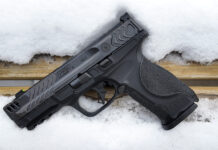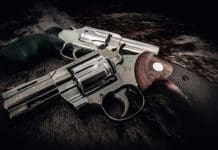http://www.youtube.com/watch?v=zMevViBUFgA
[Responding to the post 1911 Unsuitable for Self-Defense?] In my weekly matches, I often RO individual stages when needed. I have seen a few AD’s, but I would like to point out that they aren’t exclusive to 1911’s. They occur in all classes, even Grand Master, and in all divisions. Five, ten, and twenty years of practice means nothing unless it was proper practice. While it certainly will make you a better gun handler in the long term, action and competitive shooting does nothing to advance your basic fundamental skill-set in and of itself. I would argue that action shooting will actually amplify any fundamental flaw (such as trigger control) and will force you to become a better handler in order to be competitive.
As an RO, we expect new shooters to make mistakes and have flaws in their matches. It is OK as long as there is a large enough safety margin. As they say, you can’t make an omelet without breaking some eggs. It may sound dangerous, but IPSC is in the top 5 of the safest sports in the world, most injuries coming from sprained ankles.
To new readers of TTAG, let me be the first to say that ANY study showing how LEO reacts/acts under pressure isn’t worth a damn. From the LEO’s I’ve spoken with, and from what I have read on Federal/State reports, local LEO’s only practice 4 times a year (on average, special groups and SWAT aren’t included). I would point out that this is “practice” and not “real world shit my pants training.” Practice in this scenario means shooting at a paper target to prepare for an upcoming qualification shoot. LEO officers are great people and I thank them all the time for their service (same goes for military and veterans).
However, I do NOT consider them to be “experts” in firearms or firearm handling simply because their job requires them to handle/carry a gun. The guy standing on my neighbor’s roof with a hammer isn’t considered an architect or an expert carpenter because he is carrying a hammer. He’s just a guy nailing in new plywood.
To put LEO training on the upper echelon of advanced firearm skills would be like granting a Kia Spectra a “Sports Car of the Year” award. We must not forget the fact that Glock had to design a new trigger package with an 11# pull to stop NYPD cops from shooting themselves in the leg! Did you ever here the expression “he got Glocked”? That is where it came from. Look at what the study you referenced had to say. Officers were “subconsciously travel(ing) to the trigger to confirm its position.”
Answer me this. Where the heck did they think the trigger went to? Did it decide to take a lunch break during a shootout? The trigger is where the trigger is – just in front of the frame, behind the trigger guard. I’m surprised by all these reports that LE doesn’t require Glock, S&W, and Springfield to put a “–>This Way Forward –>” sticker on the slide.
That same report mentions that many of the individuals that rode the trigger were “highly-skilled and motivated officers”. Well, I’m not one to pick on people I do not know, but we need to call a spade a spade. “Highly-skilled” is subjective – what you or I consider to be highly skilled is likely very different than what Lt. Dave considers highly skilled. The same goes for “motivated”.
Motivated, in this case, serves no purpose in his comment other than to reassure the local news media and good people of Montgomery County that his staff is working to improve their skills and won’t likely shoot somebody on accident (hopefully). I highly doubt that if 674 FBI, CIA, or Secret Service Agents were tested that the numbers would be this high. As a matter of fact, if any is willing to run the test and prove me wrong, then I will give them my entire firearm collection!
I will agree with the Rabbi that a 1911 isn’t for everyone and will agree that for the general public, a single-action pistol with frame-mounted safety isn’t the best pistol for the job. A fairly sensitive trigger, combined with the limited number of rounds isn’t the best defensive pistol for someone who “practices” five or six times a year, and who – in a SHTF situation – will spray off an entire clip in 8 seconds.
However, if a 1911 is considered “unsuitable” because of its light trigger, then my SIG can be too as its SA pull is pretty light. I’m sure the same applies to any DA/SA gun, where subsequent shots are SA (CZ75 SP01 has a great SA trigger). This leaves us with Glocks (kill me now!), Springfield XD’s (I can live with that), or other striker-fired weapons (I’ll stick to the XDM). The truth of the matter is that only perfect practice makes perfect, regardless of what gun you use.
BTW – did the Rabbi’s 1911 have a trigger job?




Please note in this case, I'm the guy shooting!
"clip"
AHHHHH!
Yes, yes – I know, I broke some CFR or military law by referring to a magazine as a "clip". In reality, how many semi-automatic pistols use an actual clip? I don't know of any. The use of "clip" when referring to the magazine in semi-auto pistols is commonplace. It is a carryover from the usage of the word "clip" by the LEO community during the days when wheel guns were all the rave. Get over it, the rest of the world has 🙂
I have the same regard for all single action triggers-not only those on 1911s.
While I agree that most cops are not firearm experts, and many are far from accomplished shooters, so are the vast majority of gun owners.
Most gun owners rarely practice and most are not very proficient. Remember, we are not talking about the circle of gun friends that we as gun people have, we are talking the everyday guy who owns a gun. The entire point of my article is that it is easier to have a negligent discharge with a single action trigger than with a double-action-only trigger.
I agreed before and still do. I didn't want readers to get the impression that DA or striker-fired guns are "AD Proof" though.
Something which I think weapons handlers, professional or otherwise, should work on is eschewing the adjective "accidental" to describe these events. "Accidental" is a weasel word; they are negligent discharges, no matter what the circumstances which produce them. Recycling the "guns don't kill people, people kill people" line, I think it's best we remember "accidents don't kill people, negligence kills people."
It seems to me the situation most likely to produce a negligent discharge is a tactical reload. If one is following the third and fourth safety rules (Keep your weapon on safe until you are ready to fire. Keep your finger straight and off the trigger until you intend to fire.), then the only time it should be possible to negligently discharge the weapon under stress is while attempting to reload with the weapon off safe. Otherwise, the gun should be on safe until the moment before it is necessary to fire, and immediately back on safe once firing is no longer necessary. In this case, it might be useful to practice these reloads where the last round in the mag is a snap cap or dummy cartridge as both a safety and training measure. If the finger is finding its way into the trigger guard during reloading, that's a major problem.
Comments are closed.